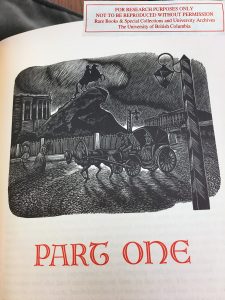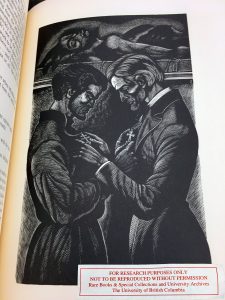The illustrations in this edition of Dostoevsky’s The Idiot by Fritz Eichenberg are easily identifiable due to the artist’s unique stylistic attributes. The printed woodcut engravings make extraordinary use of light and shadow through the manipulation of line. Some areas of the engraving are solid blocks of shadow, while simultaneously, delicate and subtle transitions between light and shadow allow Eichenberg to produce dramatic chiaroscuro effects.

Title page of part one (of four). Engraving by Fritz Eichenberg.

Title page of part two (of four). Depicts the meeting of Prince Myshkin and Parfyon Rogozhin standing under a Hans Holbein painting reproduction of The Body of the Dead Christ in the Tomb (1520-22). Engraving by Fritz Eichenberg.

Engraving depicting Prince Myshkin and Parfyon Rogozhin’s exchange of crosses. Engraving by Fritz Eichenberg.

Engraving depicting Ippolit Terentyev’s suicide attempt. Engraving by Fritz Eichenberg.
What defines Eichenberg’s style of engraving is heavily influenced by a combination of elements from the traditional techniques of German Northern Renaissance woodcut engravings, as well as German Expressionist engravings. The angular characteristics of the figure’s faces, especially recalls the influence of German Expressionism on Eichenberg’s style.
